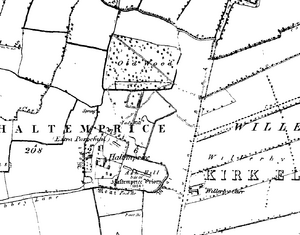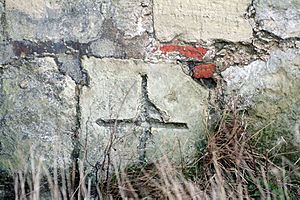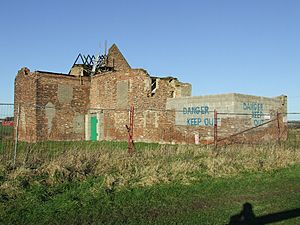Haltemprice Priory facts for kids
Quick facts for kids Haltemprice Priory |
|
|---|---|
| Religion | |
| Affiliation | Augustinian |
| Ecclesiastical or organizational status | Priory |
| Year consecrated | 1326 |
| Location | |
| Location | Willerby, England |
Haltemprice Priory was an Augustinian monastery located about two miles south of Cottingham in the East Riding of Yorkshire, England. A monastery is a place where monks or nuns live and worship. The original buildings of the priory are now gone. However, you can still see parts of a farmhouse built in 1584 on the site. This farmhouse uses some of the original stone from the priory.
Contents
Why Haltemprice Priory Was Built
In 1320, a very important church leader called Pope John XXII gave permission for a man named Thomas Wake to start an Augustinian monastery. Thomas Wake owned land in Cottingham. He wanted to build the monastery there, using the local church.
Some old records suggest that the first priory was actually built in Cottingham. Monks from another monastery had even moved in. But then, a problem came up. English law at the time meant that Thomas Wake's family could have ordered the priory to be torn down later.
Because of this, the Pope gave new permission. He said the priory could be moved to a different, safer place. So, with permission from both the Pope and King Edward II, Thomas Wake moved the monastery. He chose a place called Newton, which is now a deserted medieval village about two miles south of Cottingham.
History of the Priory
How the Priory Started
In 1325, when the priory was officially founded, Thomas Wake gave it many gifts. He gave the priory control over the areas of Newton, Willerby, and Wolfreton. This included the rent from people living there and the services of their workers, known as serfs.
He also gave the priory half of the money collected from the market and fairs in Cottingham. Plus, he gave them the right to choose the priests for the churches in Cottingham, Kirk Ella, Wharram Percy, and Belton. This right was called "advowson."
The Priory's Best Years (1320–1342)
The years between 1320 and 1342 were the best for Haltemprice Priory. It became very powerful and owned a lot of land. This land stretched from Willerby to Cottingham, Kirk Ella, and Southwood.
Even though Thomas Wake had his own problems, like money troubles and his castle being captured, he kept giving gifts to the priory. These gifts stopped in 1342. Thomas Wake died in 1349 and was buried at the priory.
When Things Got Tough (1342–1534)
After 1342, the priory started to struggle. It got into a lot of debt and wasn't managed very well. There were also many expensive legal battles. All these problems meant the priory didn't have enough money. People stopped giving as many donations.
The situation was very bad. When Thomas Wake died in 1349, the priory buildings were still not finished. Things got even worse as money ran out. In 1411, a report to Pope John XXIII said that a strong wind had knocked down the bell-tower. This damaged the church and other buildings. A fire also destroyed the priory's main gate and nearby offices. The priory was in such poor condition that it was not a good place to live.
From 1415 to 1458, Haltemprice Priory didn't have to pay royal taxes. This was because it was known to be very poor.
In 1515, there was a fight between John Wymersley, who was the head of Haltemprice Priory, and Edward Mattison, the Sheriff of Hull. They argued over who had control of Willerby and Wolfreton. A small battle even happened! The Mayor of Hull had to step in to stop it. The argument was finally settled three years later in a special court called the Court of Star Chamber. The court decided that Hull could control the freshwater springs, but the priory kept the rights to Willerby and Wolfreton.
The End of the Priory
During the Dissolution of the Monasteries, a time when King Henry VIII closed down many monasteries in England, Haltemprice Priory was visited. In 1536, two officials, Richard Layton and Thomas Legh, reported on the priory. They said it had a prior (the head monk) and nine canons (other monks), along with forty servants and boys. Haltemprice Priory was officially closed down on August 12, 1536.
Important Burials
Haltemprice Priory Farm
The Haltemprice Priory Farmhouse was built between the 15th and 16th centuries. It was changed a bit in the late 1700s. People believe that some of the stone used to build the farmhouse came from the old priory after it was closed.
The farm was lived in until 1988. After that, it became empty and was damaged by fire in the late 1990s and early 2000s. This building is very important historically. It is a Grade II* Listed Building, which means it has special architectural or historical interest. It was first listed in 1951. The priory site itself is also protected as a Scheduled Monument, starting in 1957. Today, the farm is on the Heritage at Risk Register, meaning it needs care to prevent further damage.




